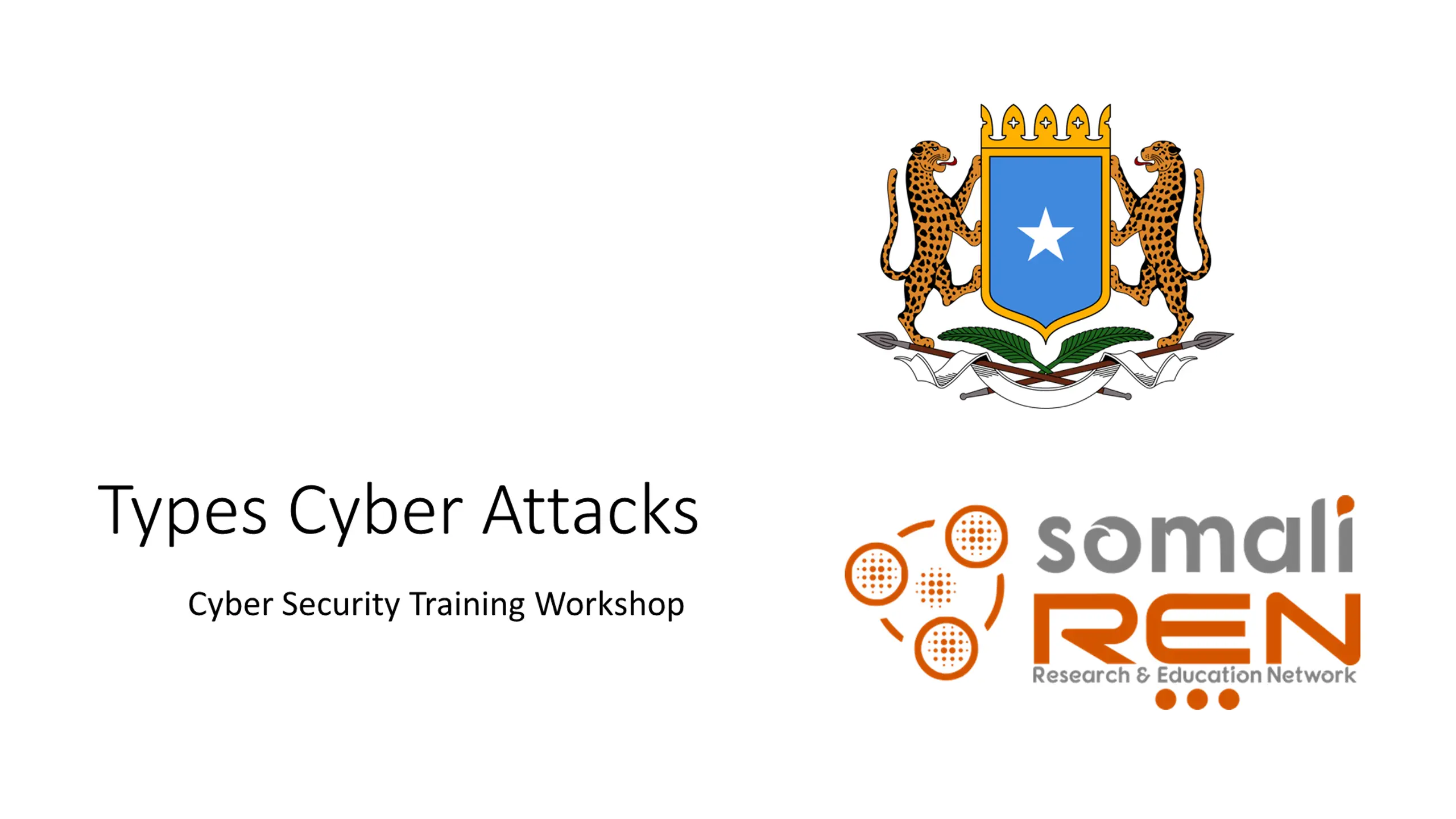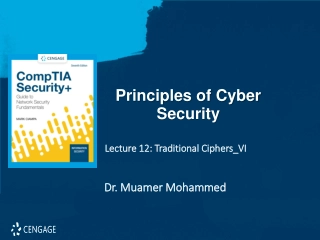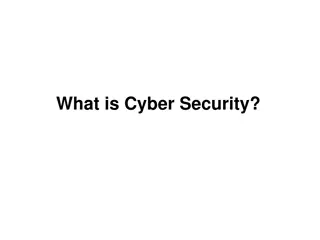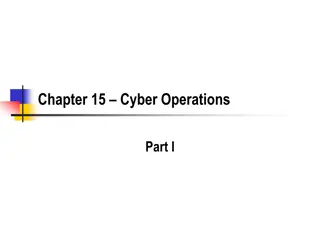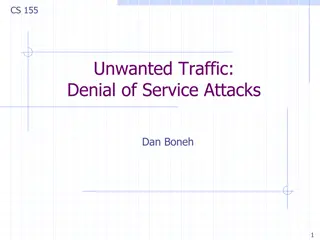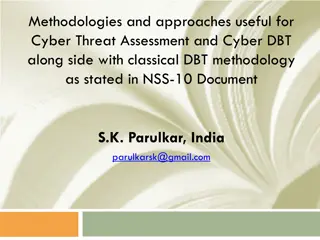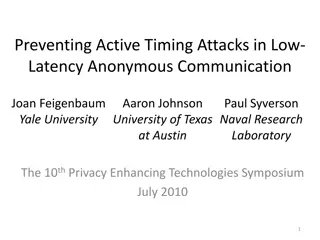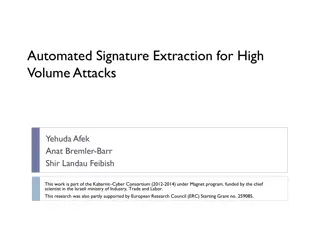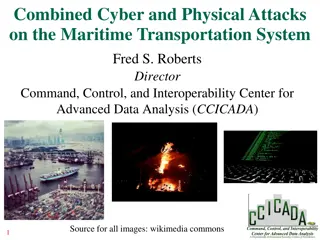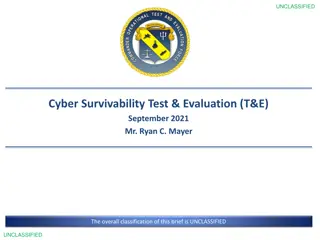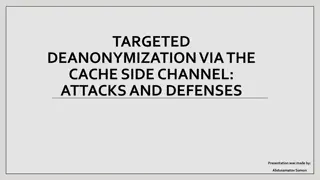Types Cyber Attacks: Cyber Security Training Workshop
Join our Cyber Security Training Workshop to learn about different types of cyber attacks such as social engineering attacks, DDoS attacks, malware attacks, MitM attacks, APTs, and password attacks. Enhance your knowledge and skills in cyber security.
Download Presentation

Please find below an Image/Link to download the presentation.
The content on the website is provided AS IS for your information and personal use only. It may not be sold, licensed, or shared on other websites without obtaining consent from the author.If you encounter any issues during the download, it is possible that the publisher has removed the file from their server.
You are allowed to download the files provided on this website for personal or commercial use, subject to the condition that they are used lawfully. All files are the property of their respective owners.
The content on the website is provided AS IS for your information and personal use only. It may not be sold, licensed, or shared on other websites without obtaining consent from the author.
E N D
Presentation Transcript
Types Cyber Attacks Cyber Security Training Workshop
Types of Cyber Attack Social engineering attacks(Phishing ) Distributed denial of service (DDoS) Malware attack Man-in-the- middle attack (MitM) Advanced persistent threats (APT) Password attacks
A malware attack is a common cyberattack where malware (normally malicious software) executes unauthorized actions on the victim s system. The malicious software (a.k.a. virus) encompasses many specific types of attacks such as ransomware, spyware, command and control, and more. Malware attack
Objective: What the malware is designed to achieve Delivery: How the malware is delivered to the target Concealment: How the malware avoids detection Three main aspects of Malware
Exfiltrate Information- Stealing data, credentials, payment information, Malware focused on this type of theft can be extremely costly to a person, company, or government target that falls victim. Disrupt Operations - Actively working to cause problems for a target s operation is another objective seen in malware. Demand Payment- Some malware is focused on directly extorting money from the target. Ransomware is a type of malware that attempts to prevent a target from accessing their data (usually by encrypting files on the target) until the target pays up. Objectives of Objectives of Malware Malware
Trojan Horse: This is a program which appears to be one thing (e.g. a game, a useful application, etc.) but is really a delivery mechanism for malware. Virus: A virus is a type of self-propagating malware which infects other programs/files (or even parts of the operating system and/or hard drive) of a target via code injection. Worm: Malware designed to propagate itself into other systems is a worm. While virus and trojan horse malware are localized to one infected target system, a worm actively works to infect other targets (sometimes without any interaction on the user s behalf). Main types of malware attack vectors
Ransomware Arguably the most common form of malware, ransomware attacks encrypt a device s data and holds it for ransom. If the ransom isn t paid by a certain deadline, the threat actor threatens to delete or release the valuable data (often opting to sell it on the dark web). Spyware Cybercriminals use spyware to monitor the activities of users. By logging the keystrokes a user inputs throughout the day, the malware can provide access to usernames, passwords, and personal data. Spyware often leads to credential theft, which in turn can lead to a devastating data breach. It often originates in corrupt files, or through downloading suspicious files. Bots is a software program that performs an automated task without requiring any interaction. Bots can execute attacks much faster than humans ever could. Main types of malware attack vectors
Continuous User Education Use Reputable A/V Software Ensure Your Network is Secure Perform Regular Website Security Audits Create Regular, Verified Backups Best practices Best practices against malware against malware attacks attacks
Social engineering is the term used for a broad range of malicious activities accomplished through human interactions. Social engineering attacks work by psychologically manipulating users into performing actions desirable to an attacker or divulging sensitive information. Social engineering attacks(Phishing )
Phishing scams are email and text message campaigns aimed at creating a sense of urgency, curiosity or fear in victims. Spear phishing is a more targeted version of the phishing scam whereby an attacker chooses specific individuals or enterprises. Baiting attacks use a false promise to pique a victim s greed or curiosity. They lure users into a trap that steals their personal information or inflicts their systems with malware. Scareware involves victims being bombarded with false alarms and fictitious threats. Piggybacking and tailgating both refer to a type of attack in which an authorized person allows an unauthorized person access to a restricted area. Social Social engineering engineering attack attack techniques techniques
Voice phishing (vishing) phone calls may be automated message systems recording all your inputs. Sometimes, a live person might speak with you to increase trust and urgency. SMS phishing (smishing) texts or mobile app messages might include a web link or a prompt to follow-up via a fraudulent email or phone number. Email phishing is the most traditional means of phishing, using an email urging you to reply or follow-up by other means. Web links, phone numbers, or malware attachments can be used. Common Phishing Technique in Somalia
Dont open emails and attachments from suspicious sources. Use multifactor authentication Be wary of tempting offers Keep your antivirus/antimalware software updated Social Social engineering engineering prevention prevention
Discussion Is Mobile Begging considered a Scam?
A Denial-of-service attack (DoS attack) is a cyber-attack in which the perpetrator seeks to make a machine or network resource unavailable to its intended users by temporarily or indefinitely disrupting the services of a host connected to a network. Denial of service is typically accomplished by flooding the targeted machine or resource with superfluous requests in an attempt to overload systems and prevent some or all legitimate requests from being fulfilled. Denial Denial- -of of- - service service attack attack (DoS attack) attack) DoS
A distributed denial-of-service (DDoS) attack is a malicious attempt to disrupt the normal traffic of a targeted server, service or network by overwhelming the target or its surrounding infrastructure with a flood of Internet traffic. DDoS attacks don t attempt to breach your security perimeter. Rather, a DDoS attack aims to make your website and servers unavailable to legitimate users. Distributed Denial of service (DDoS)
A botnet is a collection of hijacked connected devices used for cyber attacks that are controlled remotely from a Command & Control Center (C&C). Attackers use malware and other techniques to compromise a device, turning it into a zombie in the attacker s botnet. Botnets enable attackers to carry out DDoS attacks by harnessing the power of many machines and obscuring the source of the traffic. DDoS DDoS botnets botnets
DDoSsers, booters and stressers DDoS for hire: DDoS for hire:
Volume-based attacks, Protocol attacks, and Application layer attacks. There are 3 types There are 3 types of DDoS Attacks: of DDoS Attacks:
Reduce Attack Surface Area -One of the first techniques to mitigate DDoS attacks is to minimize the surface area that can be attacked thereby limiting the options for attackers and allowing you to build protections in a single place. We want to ensure that we do not expose our application or resources to ports, protocols or applications from where they do not expect any communication. Deploy Firewall and load balancer - A good practice is to use a Web Application Firewall (WAF) against attacks, such as SQL injection or cross-site request forgery, that attempt to exploit a vulnerability in your application itself. DDoS Protection Techniques
An organization typically has two choices when setting up cloud-based DDoS protection: On-demand cloud DDoS mitigation: These services activate after the in-house team, or the provider detects a threat. If you suffer a DDoS, the provider diverts all traffic to cloud resources to keep services online. Always-on cloud DDoS protection: These services route all traffic through a cloud scrubbing center (at the cost of minor latency). This option is best suited for mission-critical apps that cannot afford downtime. DDoS Protection Techniques
A man in the middle (MITM) attack is a general term for when a perpetrator positions himself in a conversation between a user and an application either to eavesdrop or to impersonate one of the parties, making it appear as if a normal exchange of information is underway. The goal of an attack is to steal personal information, such as login credentials, account details and credit card numbers. Targets are typically the users of financial applications, SaaS businesses, e-commerce sites and other websites where logging in is required. Broadly speaking, a MITM attack is the equivalent of a mailman opening your bank statement, writing down your account details and then resealing the envelope and delivering it to your door. Man-in-the- middle attack (MitM)
Interception- The first step intercepts user traffic through the attacker s network before it reaches its intended destination. 1. IP spoofing involves an attacker disguising himself as an application by altering packet headers in an IP address. As a result, users attempting to access a URL connected to the application are sent to the attacker s website. 2. ARP spoofing is the process of linking an attacker s MAC address with the IP address of a legitimate user on a local area network using fake ARP messages. As a result, data sent by the user to the host IP address is instead transmitted to the attacker. MITM attack MITM attack progression(Interception) progression(Interception) 3. DNS spoofing, also known as DNS cache poisoning, involves infiltrating a DNS server and altering a website s address record. As a result, users attempting to access the site are sent by the altered DNS record to the attacker s site.
Decryption- After interception, any two-way SSL traffic needs to be decrypted without alerting the user or application. A number of methods exist to achieve this 1. HTTPS spoofing sends a phony certificate to the victim s browser once the initial connection request to a secure site is made. 2. SSL BEAST (browser exploit against SSL/TLS) targets a TLS version 1.0 vulnerability in SSL. Here, the victim s computer is infected with malicious JavaScript that intercepts encrypted cookies sent by a web application. MITM attack MITM attack progression progression (Decryption) (Decryption) 3. SSL hijacking occurs when an attacker passes forged authentication keys to both the user and application during a TCP handshake. This sets up what appears to be a secure connection when, in fact, the man in the middle controls the entire session.
Avoiding WiFi connections that arent password protected. Paying attention to browser notifications reporting a website as being unsecured. Immediately logging out of a secure application when it s not in use. Not using public networks (e.g., coffee shops, hotels) when conducting sensitive transactions. Man in the Man in the middle attack middle attack prevention prevention
Two types of phishing attacks: Regular Phishing -victims receive a phishing mail asking them to reset passwords due to security reasons. Hackers are successful when targets don t confirm the sender s authenticity before changing their passwords. Spear Phishing directed victim to click or download a link in an email from a known sender. The link takes you to a malicious look-a-like website where you log in, inadvertently sharing your password with threat actors. Different Different Types of Types of Password Password Attacks Attacks
Brute Force Attacks - In a brute force attack, hackers steal passwords with the hit-and-try method using special software. Here are two variations of such cyberattacks: Password Spraying In a password spray attack, attackers use a selection of common passwords on a massive number of accounts. They attempt to crack passwords of accounts in bulk, reducing the risk of getting traced. Dictionary Attacks- bad actors use a list of common words and phrases from a dictionary. This is the opposite of a brute force password attack as they don t use character-by-character attempts. Different Different Types of Types of Password Password Attacks Attacks
Credential Stuffing - In credential stuffing, cybercriminals use stolen credentials to break passwords set for cybersecurity. This method is based on simple human psychology: We can t remember too many passwords; so, let s use the same password for every account, right? Once hackers succeed in breaching one of your accounts, they use the same passwords on your different accounts. Keylogger Attacks attackers use malware to attempt keylogger or keystroke logger password attacks. In cybersecurity, These attacks are among the most dangerous as they reveal even the strongest and most secure passwords. Hackers record keystrokes when you enter them. Different Different Types of Types of Password Password Attacks Attacks
An advanced persistent threat (APT) is a cyber- attack in which the adversary operates undetected inside a compromised network for an extended period of time after gaining unauthorized access. APT attacks are distinguished by their use of highly sophisticated tools and techniques to evade detection, steal credentials, and move through the network to reach high-value assets. These tools and techniques require significant financial and human capital to acquire or develop, implying that APT attacks are designed to target the meanest network defenses protecting important organizations and their assets. Advanced persistent threats (APT)
APT Attack Stages APT Attack Stages
Stage 1: Target Selection and External Reconnaissance An APT attack always begins with identifying targets that satisfy the attacker s objectives. Once a target has been selected, the attackers will perform a reconnaissance of the target to discover potential points of entry (attack vectors) and gather as much information on the target as possible. Stage 2: Initial Access After thorough preparation, the attacker attempts to gain unauthorized access to the target s network by exploiting one or more viable attack vectors. One of the most common ways this is achieved is through highly deceptive social engineering techniques like spear-phishing emails. APT Attack APT Attack Stages Stages
Stage 3: Malware Execution After gaining access to the victim s network, the attacker executes the first malware payload on the compromised machine (patient zero). This initial malware payload is used to achieve a variety of broader goals such as internal reconnaissance, defense evasion, and command and control communication. Stage 4: Privilege Escalation and Lateral Movement Once the attacker establishes a firm foothold on the compromised system, they begin to harvest access credentials (user, domain admin, and service accounts) to escalate their privileges. Escalated privileges give the attacker greater freedom and cover to operate and move laterally through the network to reach high-value targets that meet their objectives. APT Attack APT Attack Stages Stages
Stage 5: Data Exfiltration and Damage Infliction After reaching the high-value assets, the APT attacker begins exfiltrating the data from the target s network to their own infrastructure. The data is typically transferred to a central location and packaged into an archive. The archive is encrypted to conceal it from deep packet inspection during exfiltration and compressed and chunked so that the data is exfiltrated in small enough quantities to resemble normal traffic activity, lowering any suspicion. APT Attack APT Attack Stages Stages
Many cybersecurity solutions such as firewalls, endpoint security, intrusion detection and prevention systems may no longer offer adequate protection against APT attacks. Essentially, these tools are designed to prevent and detect known threats using known malware signatures, known indicators of compromise (IoC), and known attack patterns. With APT threat actors constantly updating their tools, TTPs, and infrastructure, what is really needed is a solution to detect non-signature-based malware and unknown attack activity and patterns. APT Detection APT Detection and Protection and Protection Using NDR Using NDR
Network detection and response (NDR) is a security solution that performs real-time monitoring and analysis of network-wide traffic to detect and respond to malware and behavioral-based malicious activity in the network. The crux of NDR is detecting behavioral-based malicious activity. As stealthy as they are, APT activities generate network traffic in all stages of an attack, and as long as activities generate traffic, they can be detected. NDR leverages the power of machine learning, artificial intelligence, and behavioral analytics to analyze network traffic and detect granular deviations from normal network activity to uncover APT threats. What is What is Network Network Detection and Detection and Response Response (NDR)? (NDR)?
Change your passwords regularly and use strong alphanumeric passwords which are difficult to crack. Refrain from using too complicated passwords that you would tend to forget. Do not use the same password twice. Update both your operating system and applications regularly. This is a primary prevention method for any cyber attack. This will remove vulnerabilities that hackers tend to exploit. Use trusted and legitimate Anti-virus protection software. Use a firewall and other network security tools such as Intrusion prevention systems, Access control, Application security, etc. Avoid opening emails from unknown senders. Scrutinize the emails you receive for loopholes and significant errors. Make use of a VPN. This makes sure that it encrypts the traffic between the VPN server and your device. How to Prevent Cyber Attacks?
Regularly back up your data. According to many security professionals, it is ideal to have three copies of your data on two different media types and another copy in an off-site location (cloud storage). Hence, even in the course of a cyber attack, you can erase your system s data and restore it with a recently performed backup. Employees should be aware of cybersecurity principles. They must know the various types of cyberattacks and ways to tackle them. Use Two-Factor or Multi-Factor Authentication. With two-factor authentication, it requires users to provide two different authentication factors to verify themselves. When you are asked for over two additional authentication methods apart from your username and password, we term it as multi-factor authentication. This proves to be a vital step to secure your account. Secure your Wi-Fi networks and avoid using public Wi-Fi without using a VPN. Safeguard your mobile, as mobiles are also a cyberattack target. Install apps from only legitimate and trusted sources, make sure to keep your device updated. How to Prevent Cyber Attacks?
Discussion Thank you
